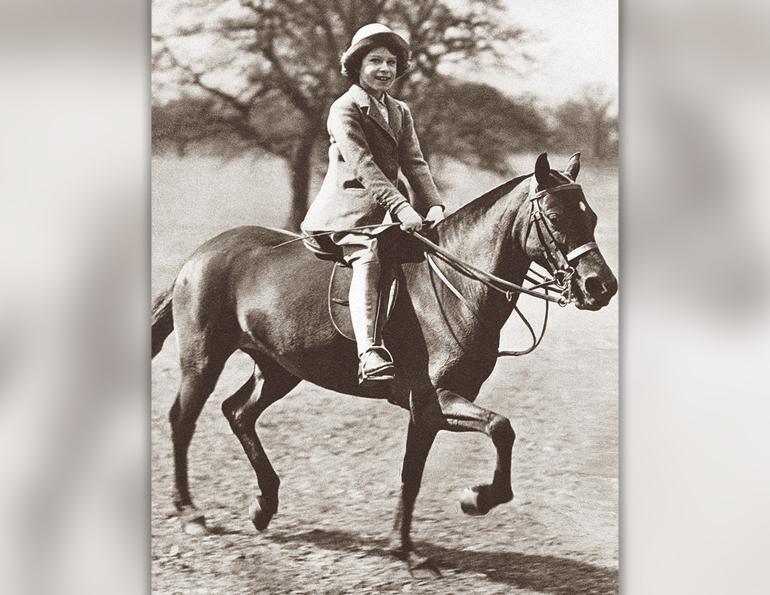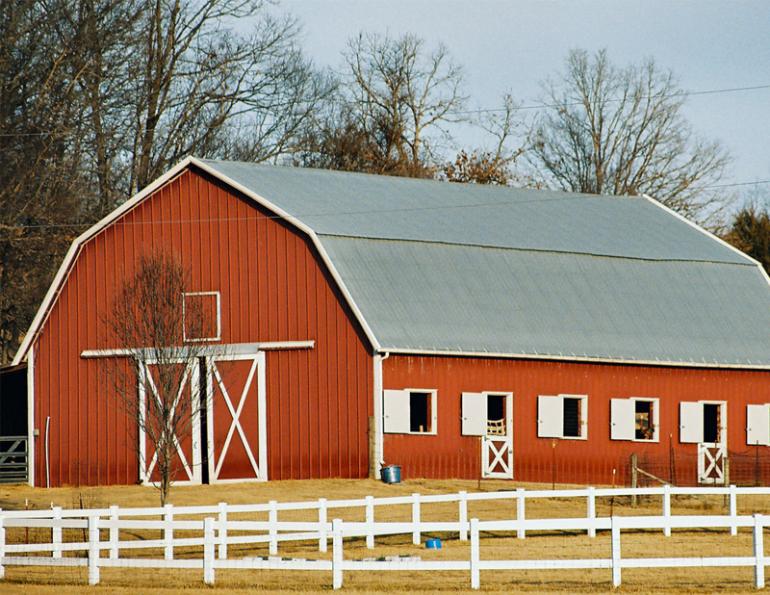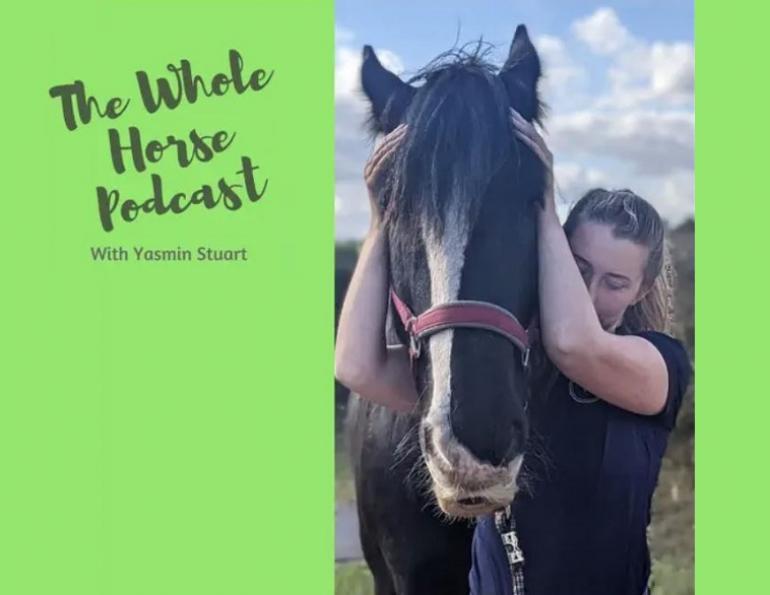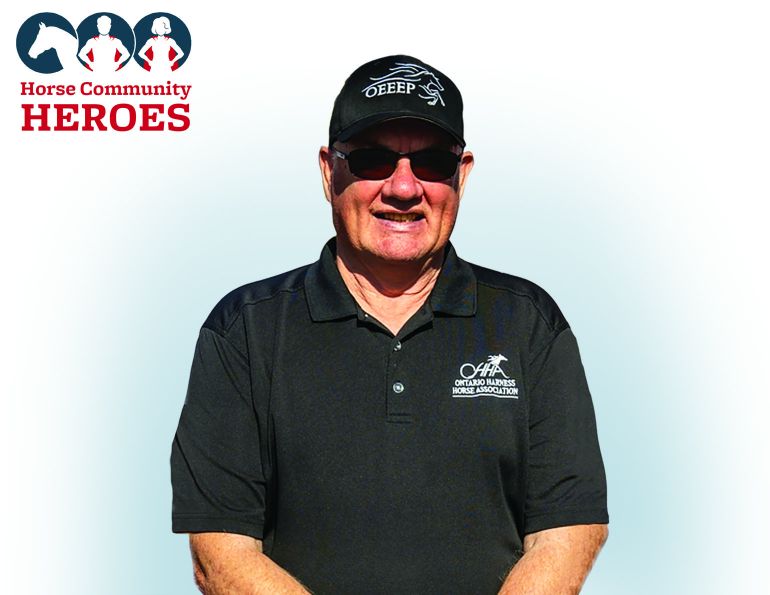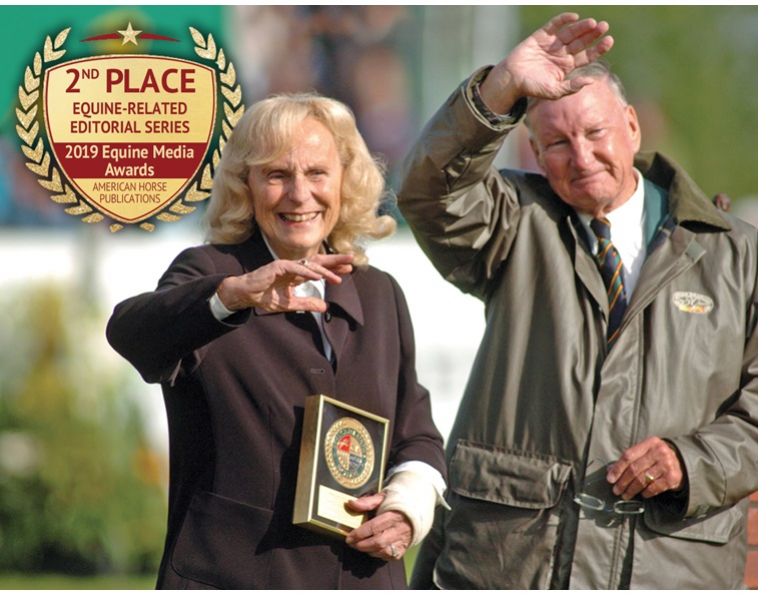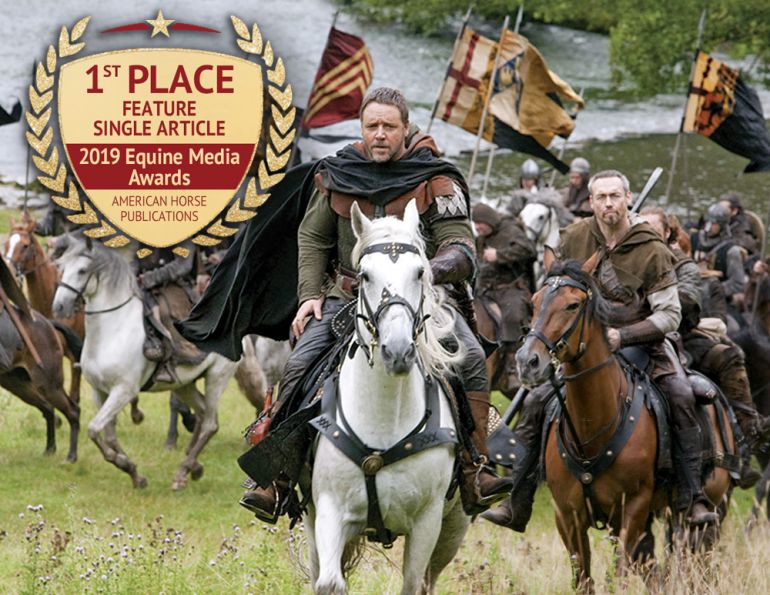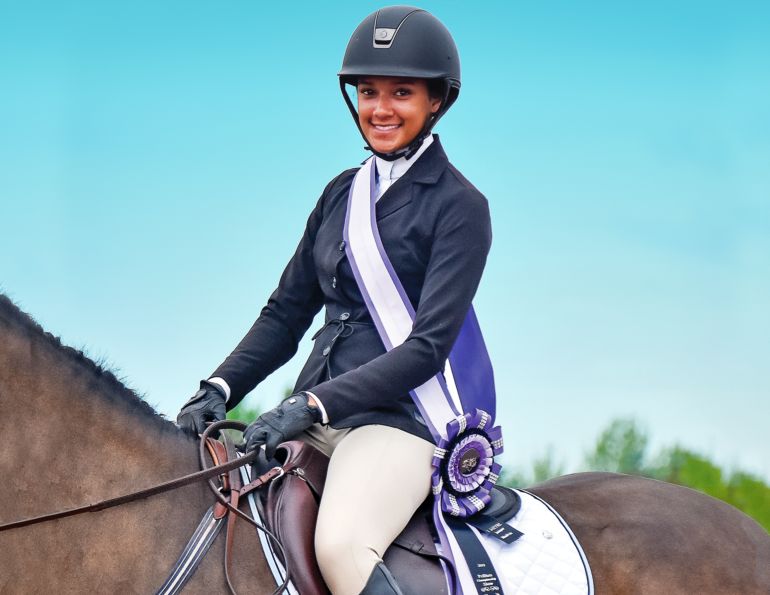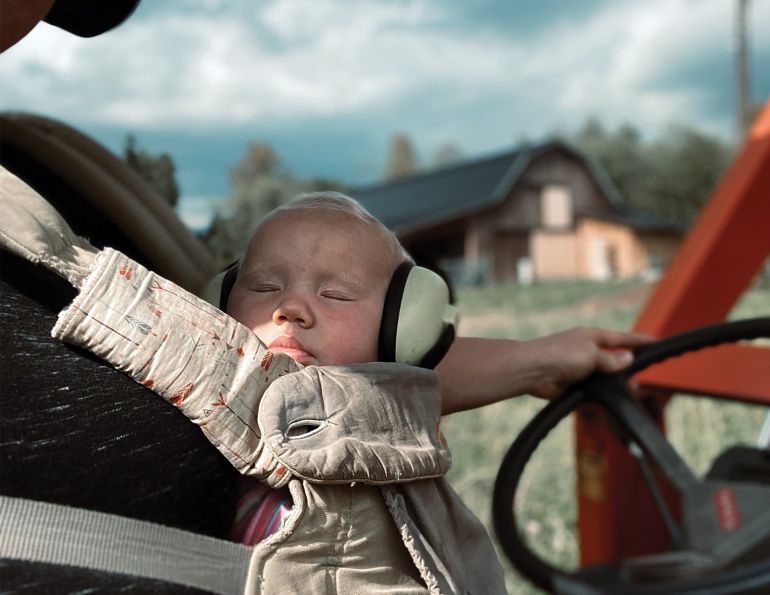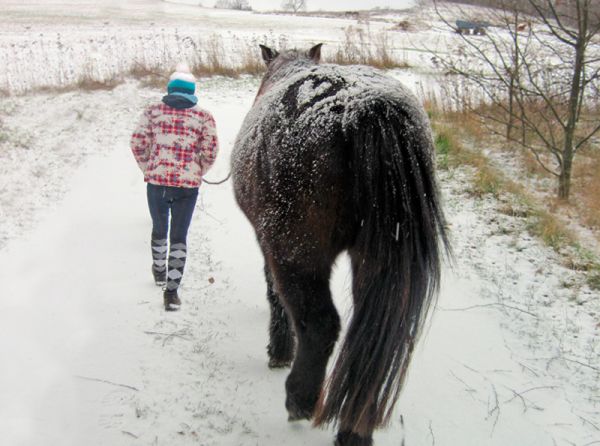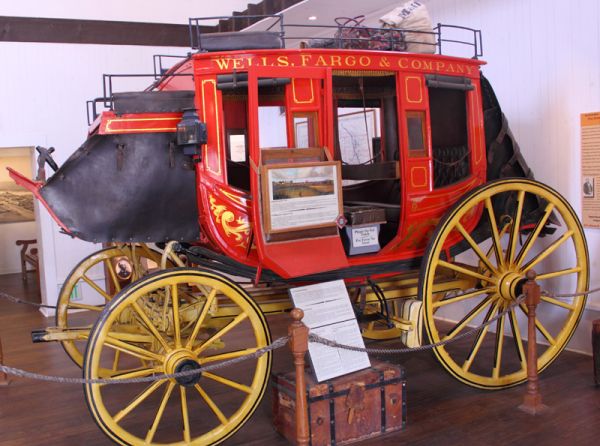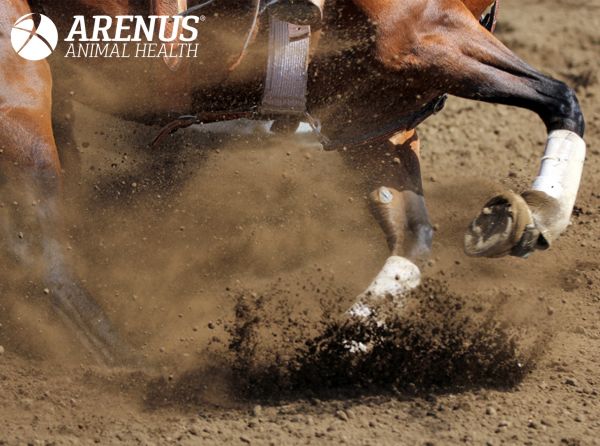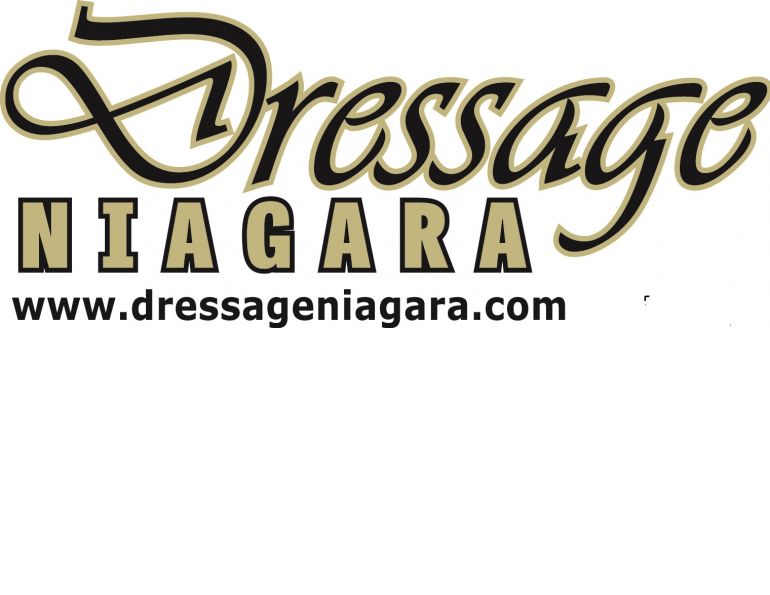By Tania Millen, BSc, MJ
The world mourned the loss of Britain's longest-reining monarch, Queen Elizabeth II, when she passed away in September 2022. Her death ushered in a new era for the monarch. Her son, Prince Charles, ascended to the throne; the words to Canada's Royal Anthem were adapted to include "God Save the King;" and, in time, King Charles III’s image will replace that of Queen Elizabeth II on Canadian currency. Despite these changes, Queen Elizabeth’s lifelong devotion to horses and her profound influence on the world of equestrianism will remain a lasting part of her remarkable legacy.
Related: Horses in Hollywood Movies
A series of unexpected circumstances led to Queen Elizabeth II’s ascent to the throne. Her uncle, Edward VIII, abdicated to marry Wallis Simpson, a divorced American woman, resulting in her father and Edward VIII's younger brother, King George VI, inheriting the crown. With no male heirs, King George VI’s eldest daughter, Elizabeth, became Queen in 1952 at just 25 years old. By this point, her lifelong love for horses had already taken root.
Princess Elizabeth began riding ponies at Buckingham Palace’s exclusive riding school at the tender age of three. By age four, she was riding a Shetland pony named Peggy, a gift from her grandfather, King George V, which she shared with her younger sister, Princess Margaret. Elizabeth’s passion for horseback riding grew as she explored the vast grounds of Windsor Castle. During her teenage years, her father took her to observe the royal racehorses in training, particularly during World War II. The Queen later reminisced about the experience, recalling how she had stroked the Thoroughbreds in the stables and said, "I’d never felt the satin softness of a Thoroughbred before," marking a pivotal moment in her lifelong connection to the equestrian world.

Main Photo: Alamy/Country Queen
As a 21-year-old princess in 1947, the Queen attended the annual Trooping the Colour (a ceremonial military parade) on horseback and continued to do so until age 60 in 1986. Ultimately, the Queen rode well into her 90s, which enthralled and inspired Canadian riders — particularly women in the latter years of their own lives.
The Queen was highly regarded in many parts of the horse world.
“The Queen was a very good horsewoman,” says Lyn Cook, a former groom for international three-day eventing riders who were based at Gatcombe Park in England in the 1990s. “She had an affinity for horses.”
Related: A Carriage Ride Through History

The bay Thoroughbred, Sultan, was given to the Queen by the President of Pakistan in 1959. Windsor Castle is in the background of this photo taken on May 18, 1961. Photo: Alamy/Smith Archive
Cook was fortunate to hack one of the Queen’s horses around Balmoral Estate in Scotland one day, when its regular groom was busy, and is acquainted with the royal family.
“Horses have played a big part in the royal family for generations,” says Cook. “All of the UK’s kings and queens have had horses in one way or another.”
The Queen embraced this royal history and became passionate about breeding and investing in horses and horse sports. “She’s an out-and-out horse addict,” said Lucy Higginson, former editor of Horse and Hound magazine, Britain’s oldest equestrian publication.
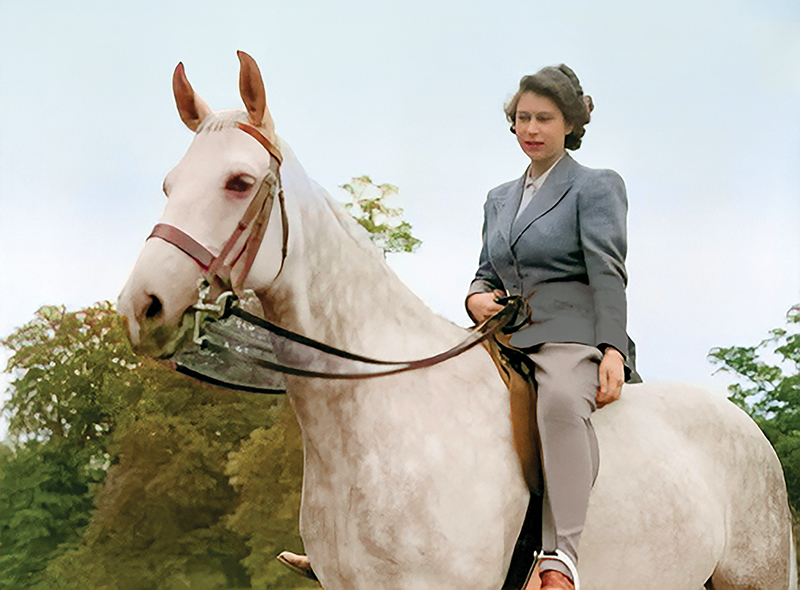
A consummate horsewoman, Queen Elizabeth’s influence extended to her family, many of whom are accomplished riders. Photo: Alamy/Country Queen
Horse Racing, Breeding and Conservation
One of the Queen’s passions was racehorses, and she bred many winning steeplechase and flat racing horses at the Royal Stud — a breeding facility in Sandringham, England which she inherited from her father King George VI.
Her Majesty’s horses won over 1,800 races including four of the five oldest and most important British Classic horse races: the Oaks, the One Thousand Guineas, the Saint Leger, and the Two Thousand Guineas. But she never owned a Derby winner, albeit not for lack of breeding, training, or running some of the best horses. In 1954 and 1957, the Queen was the champion flat racing owner in Britain.
One of the Queen’s outstanding racehorses was Estimate, who won the Gold Cup at Ascot racecourse in 2013. It was the first time a reigning monarch had owned the winner in 207 years and to commemorate the feat, a life-size statue of Estimate was commissioned. It now graces the entrance to the royal family’s Sandringham Estate in Norfolk, England.
Related: The Heritage and Skill of Riding Sidesaddle
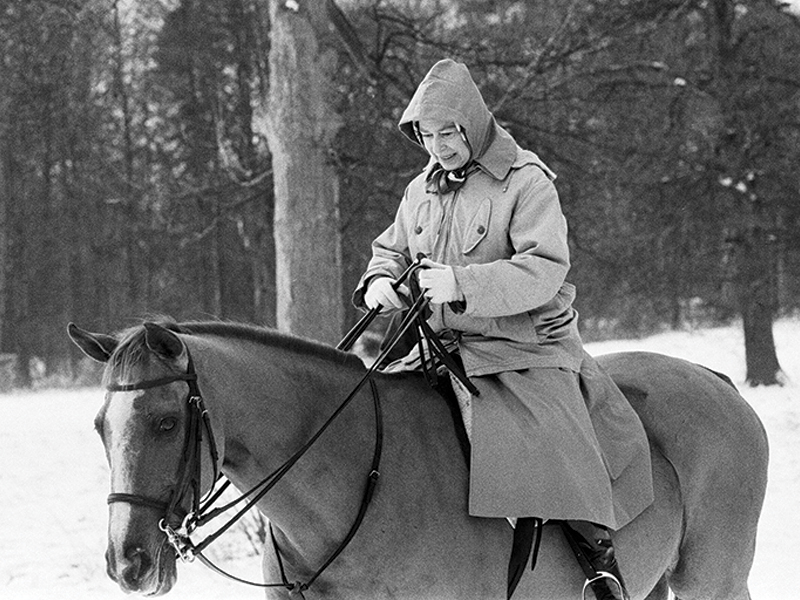
The Queen riding in the snow during the royal family’s New Year holiday at Sandringham, Norfolk. This photo was taken January 2, 1979. Photo: Alamy/Mirrorpix
The Queen’s commitment to racing didn’t go unnoticed. In 2021, she was inducted into the British Champions Series Hall of Fame to recognize her contributions to racing as an owner and breeder. Upon the Queen’s death, the Royal Stud was passed to King Charles III, who ran his first horse in the royal silks on September 29, 2022.
“The loss of Her late Majesty was keenly felt within the racing and breeding industries given her lifelong passion for the sport, and so we are naturally thrilled to see that the horses previously owned by her will race on in the ownership of His Majesty King Charles III,” said British Horseracing Authority Chair Joe Saumarez Smith on September 27, 2022 in a statement online. “Her late Majesty Queen Elizabeth II left an indelible mark on our sport and her legacy will continue to be felt, not only through the horses that will continue to run in the name of King Charles III, but also those she bred who are yet to be seen on the racecourse in the years to come.”
The Queen was instrumental in other areas of the horse world, too.
She was integral to the conservation of Cleveland Bay horses, which originated as a multi-purpose farm, coach, and road horse in the Cleveland district of Yorkshire, England. Interestingly, they were originally known as Chapmen’s (travelling salesmen’s) Horses and were once common mounts of the British royal family. But by 1960, only six purebred Cleveland Bay stallions remained alive. Her Majesty’s grandfather had bred Cleveland Bays, so the Queen stepped up to help conserve the breed. In 1961, she purchased a pure Cleveland Bay colt named Mulgrave Supreme and stood him at stud. This sparked demand for Cleveland Bays, which now number about 1,000 horses worldwide.
Related: The Kelpie - Mythological Water Horse of Scotland
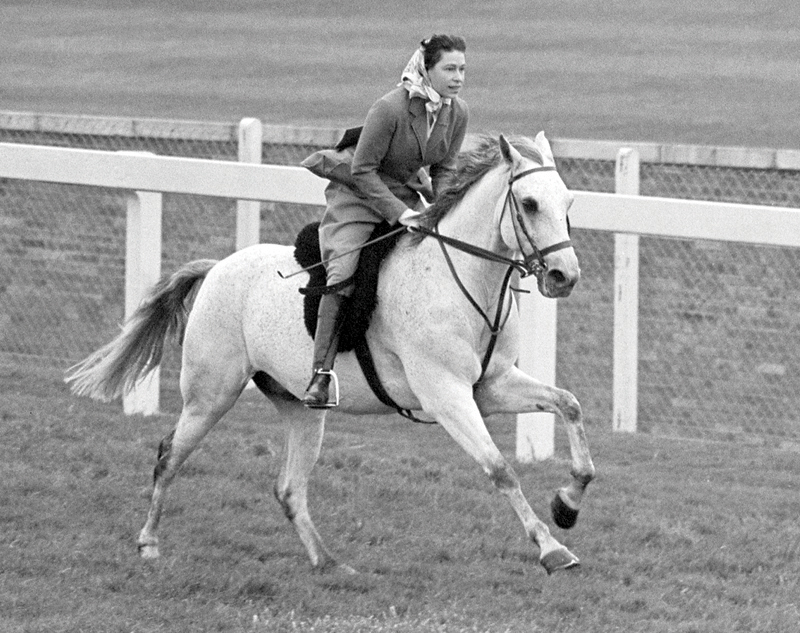
Queen Elizabeth galloping a horse named Surprise on Ascot racecourse in June 1961. Photo: Alamy/PA Images
The Queen also bred Fell ponies — one of five native English pony breeds — which she named with a Balmoral prefix. Fells originated in northern England and were used as pack animals in the 1800s lead-mining industry. The Queen was the patron of the Fell Pony Society for 40 years and helped give the breed exposure by riding them herself.
The Queen bred Highland ponies at Balmoral Estate, too. Originally bred to work on small Scottish farms, they’re now used as workhorses or for jumping and trail riding due to their quiet nature and stamina. The Queen’s breeding operation has helped stabilize the numbers of Highland ponies worldwide.
She also bred Shetland ponies and was patron of the British Horse Society, the Highland Pony Society, the Shire Horse Society, the Welsh Pony and Cob Society, and the Thoroughbred Breeders’ Association.
In recognition of her expansive support for horse sport in the United Kingdom and Commonwealth countries the Queen received the first FEI Lifetime Achievement Award in 2014.
Related: The Fell Pony: a Heritage Classic
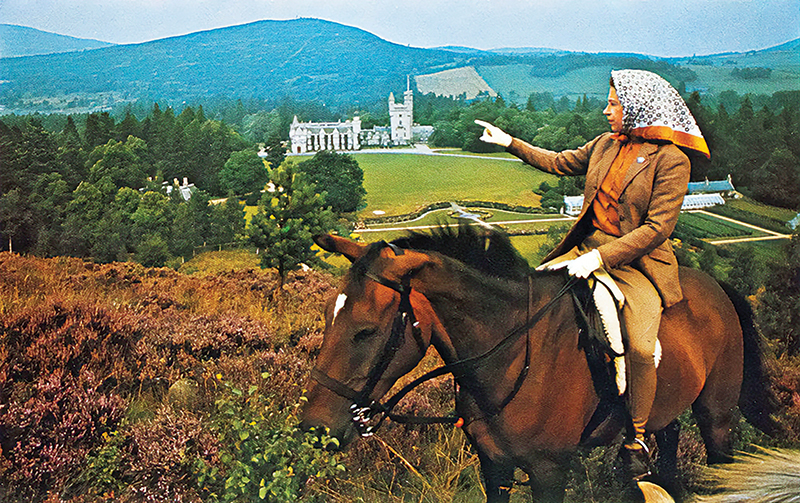
Enjoying a trail ride at Balmoral Castle in Scotland. Photo: Alamy/Country Queen
That support was ongoing. Every year, the Queen hosted the Royal Windsor Horse Show at Windsor Castle. It’s the largest outdoor premier show in the United Kingdom and is known worldwide for both its entertainment and horse sport excellence. There are public displays by The Musical Ride of the Household Cavalry Mounted Regiment, The Mounted Band of the Household Cavalry, and The Musical Drive of the King’s Troop Royal Horse Artillery, plus international-level show jumping, driving, endurance, and showing. She was often seen attending the show, congratulating winners, and supporting family who were competing.
As a fitting tribute to the Queen’s love of horses, part of her 2022 Platinum Jubilee Celebration included an equestrian-themed Gallop Through History. Split into four acts, the spectacle told the story of the Queen’s reign using over 1,000 performers and 500 horses.
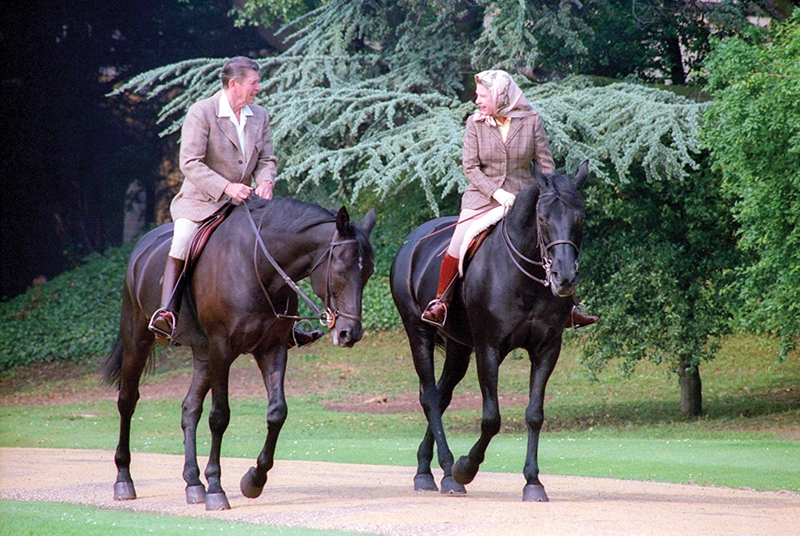
US President Ronald Reagan riding Centennial, with Queen Elizabeth II riding Burmese, during the president’s visit to Windsor Castle, June 8, 1982. Photo: White House Photographic Collection
A Family of Horse Lovers
The Queen’s horsey influence extended to her family, too.
“Horses play a big part in the whole family, and I think a lot of that stems from the Queen,” says Cook. “They’re all very competent and capable riders.”
His Royal Highness Prince Philip, Duke of Edinburgh, the Queen’s husband who passed away in 2021 at age 99, was also a strong advocate for horse sport. He was president of the FEI for 22 years and won the World Championship gold medal for driving in 1980. Prince Philip also donated the original Prince Philip Cup to the British Pony Club in the 1950s. Canada’s Prince Philip Cup was named by permission of His Highness and is awarded annually to the best Pony Club Prince Philip Cup Games team in the country.
“King Charles is also a very good horseman,” says Cook. The King played polo for 40 years before retiring in his late 50s; in his younger years, he was steeplechasing. His sons, Prince William and Prince Harry, were keen polo players, too. Queen Camilla was an excellent rider as well, foxhunting into her late 50s.
Related: In Memoriam: FEI Pays Tribute to Longest Serving FEI President Prince Philip
Her Royal Highness, Princess Anne, was a well-known three-day eventing rider. She won the European Eventing Championships at age 21, rode at Badminton and Burghley, was on the British eventing team for five years, won silver medals at the 1975 World Championships, and competed at the 1976 Montreal Olympics. The Princess Royal has been a patron of the Riding for the Disabled Association since 1971, and from 1986 to 1994 she was the FEI President.
“The Princess Royal still rides and has horses at home,” says Cook.
Zara Tindall (nee Phillips) — the Princess Royal’s daughter — is a world-class three-day eventing rider.
“Zara is still riding professionally at top level and has a good string of horses,” says Cook. “She’s a big part of the British three-day eventing team.”
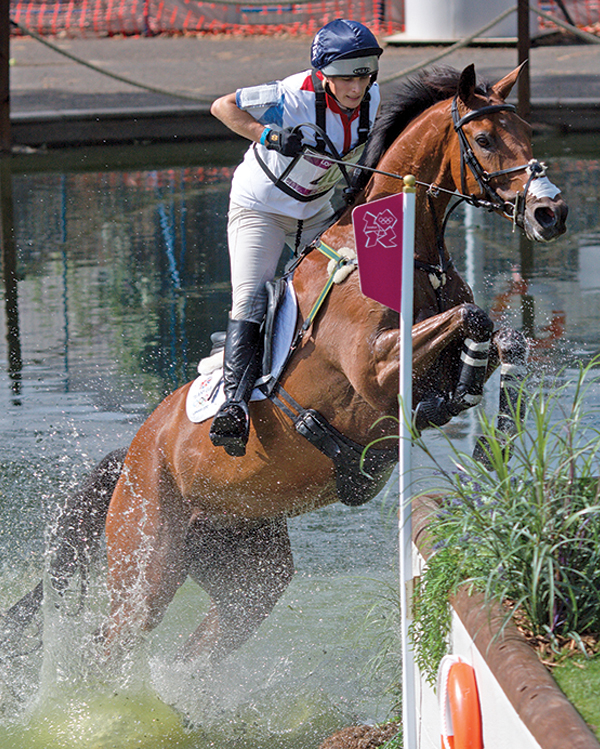
Zara Tindall, the eldest granddaughter of Queen Elizabeth and Prince Philip, competing for Great Britain on High Kingdom during the cross-country phase of the Three-Day Eventing during the 2012 Olympic Games in London. Photo: Wikimedia/Lazy Photography
Tindall won gold medals at the 2005 European Eventing Championships, individual gold and team silver medals at the 2006 World Equestrian Games, and a team silver medal for Great Britain at the 2012 London Olympics.
The Queen’s granddaughter, Lady Louise Mountbatten-Windsor, has been bitten by the carriage driving bug and in 2021, inherited her grandfather's (Prince Philip’s) driving ponies and carriage.
Related: Rare Jewel: A Hockey and Horses Story
Canadian Connections
Queen Elizabeth II reigned for 70 years and 214 days — the longest of any British monarch and the longest verified reign of any female sovereign in history. She was Queen of the United Kingdom and 15 Commonwealth realms, including Canada.
“Horses and horse sport are very much part of Commonwealth culture and that comes from the royal family,” says Cook.
The monarchy is represented in Canada at the federal level by Canada’s current Governor General, Ms. Mary Simon, while lieutenant governors represent the King in each Canadian province. But the monarch’s influence in the horse world is perhaps better known.

Above: The Queen receiving Police Service Horse Burmese from Commissioner Malcolm Lindsay and S/Sgt. Ralph Cave (Riding Master for the RCMP Musical Ride). Photo: RCMP Historical Collection, RCMP Veterans Association

Above: Riding Burmese during The Trooping the Colour ceremony in London. The Queen rode Burmese at every Trooping the Colour ceremony for 18 years. The ceremony has marked the official birthday of the British Sovereign for more than 260 years. Photo: Flickr/Leonard Bentley
The Queen’s Plate, a 1.25 mile (two kilometre) horse race held at Woodbine Racetrack in Toronto, Ontario every summer, is the longest continuously run stakes race in North America. It began in 1860, offering “a plate to the value of 50 guineas.” (A guinea was a coin containing one-quarter of an ounce of gold, and was worth one pound and one shilling, or £1.05). The purse is now $1 million Canadian dollars and a gold cup; however, every year Buckingham Palace sends 50 guineas to the owner of the winning horse. Woodbine Racetrack has yet to confirm whether the race will be renamed the King’s Plate.
One of the Queen’s best-known connections to Canada was the mare Burmese. In 1969 the Royal Canadian Mounted Police (RCMP) gave the Queen a Saskatchewan-born black police service mare named Burmese, which she rode sidesaddle during The Trooping the Colour for 18 consecutive years. A bronze statue of the Queen riding Burmese is located in Regina, Saskatchewan.
Related: Remarkable Horses in Canada: Burmese
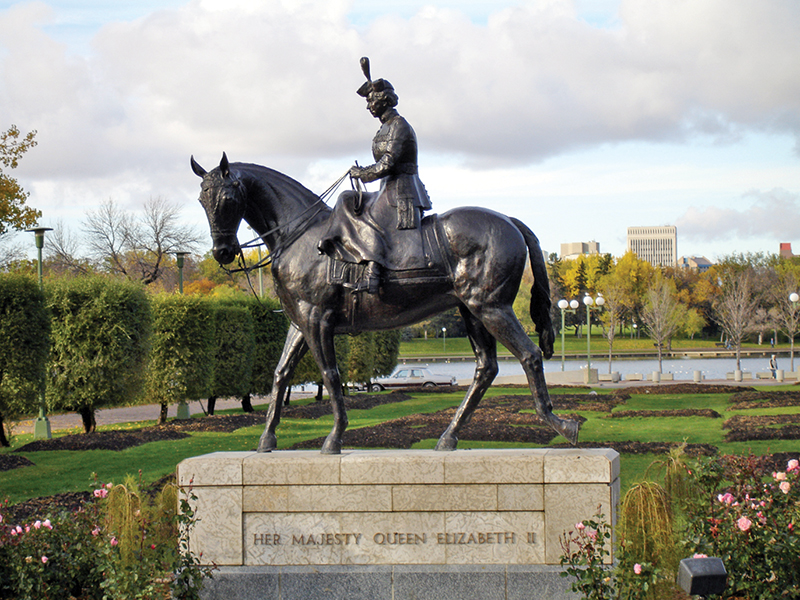
The statue of Queen Elizabeth II against the backdrop of Regina’s skyline and Wascana Lake. The statue is located on the grounds of the Saskatchewan Legislature in Wascana Park. Photo: Wikimedia/Daryl Mitchell
In keeping with the Queen’s strong Canadian connections, Equestrian Canada stated: “Her Majesty’s lifelong passion for and love of horses will forever be admired by our equestrian community.”
That was evident at the Queen’s funeral, where four RCMP officers preceded the Queen’s coffin riding Canadian horses that had previously been gifted to the Queen. They were named Darby, George, Elizabeth, and Sir John. Elizabeth had been given to the Queen for her Diamond Jubilee in 2012 and was named after the Queen Mother. RCMP Cpl. Justine Rogawski, who rode Elizabeth, said that she considered the opportunity a “great honour.”
The Queen’s extensive involvement with horses has nurtured many corners of the horse world. Her enthusiasm for riding at all ages and life stages has inspired everyday riders in Britain, Canada, and elsewhere. Although the Queen has passed away, her legacy — a passion for horses — lives on.
"Her Majesty Queen Elizabeth II was a true horsewoman and a passionate supporter of equestrian sports throughout her life and reign. Her profound love and understanding of horses were truly exceptional." - Ingmar De Vos, President of the International Equestrian Federation (FEI), in tribute to the late monarch.
Related: Horse Museum Bucket List
Related: A Country Built by Horse Power
Main: Princess Elizabeth, future Queen Elizabeth II, riding her pony in Windsor Great Park. She rode her first pony at age three at the private riding school at Buckingham Palace, and kept riding well into her 90s. Photo: Alamy/Classic Image



